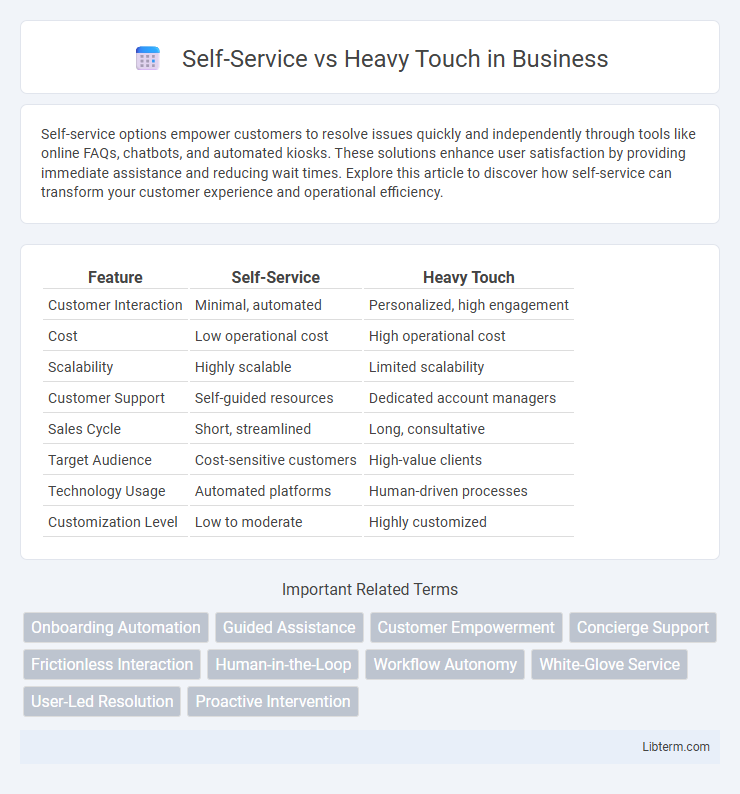Self-service options empower customers to resolve issues quickly and independently through tools like online FAQs, chatbots, and automated kiosks. These solutions enhance user satisfaction by providing immediate assistance and reducing wait times. Explore this article to discover how self-service can transform your customer experience and operational efficiency.
Table of Comparison
| Feature | Self-Service | Heavy Touch |
|---|---|---|
| Customer Interaction | Minimal, automated | Personalized, high engagement |
| Cost | Low operational cost | High operational cost |
| Scalability | Highly scalable | Limited scalability |
| Customer Support | Self-guided resources | Dedicated account managers |
| Sales Cycle | Short, streamlined | Long, consultative |
| Target Audience | Cost-sensitive customers | High-value clients |
| Technology Usage | Automated platforms | Human-driven processes |
| Customization Level | Low to moderate | Highly customized |
Understanding Self-Service vs Heavy Touch
Self-service models empower customers to independently access resources, complete tasks, and solve problems using digital tools, reducing the need for direct human interaction. Heavy touch involves personalized, high-contact support where representatives provide tailored guidance, fostering deeper customer relationships through hands-on assistance. Understanding the balance between self-service efficiency and heavy touch customization is crucial for optimizing customer experience and operational costs.
Key Differences Between Self-Service and Heavy Touch
Self-service offers automated, user-driven support that prioritizes efficiency and scalability, allowing customers to access resources and resolve issues independently. Heavy touch involves personalized, high-contact interactions where representatives provide tailored assistance, focusing on complex problem-solving and building strong customer relationships. Key differences include the level of human involvement, customization of service, and suitability for varying customer needs and complexity.
Benefits of Self-Service Solutions
Self-service solutions empower users by providing instant access to information and tools, reducing dependency on support staff and accelerating decision-making. These platforms enhance scalability and cost-efficiency by minimizing operational overhead and enabling 24/7 availability. User autonomy improves satisfaction and engagement, fostering a seamless, personalized experience that adapts to individual needs without heavy human intervention.
Advantages of Heavy Touch Approaches
Heavy touch approaches offer personalized customer interactions that enhance satisfaction and loyalty by addressing specific needs through tailored support. These strategies provide complex problem-solving capabilities, enabling businesses to manage intricate sales cycles and deliver customized solutions effectively. Companies leveraging heavy touch models benefit from stronger client relationships, increased upsell opportunities, and higher overall lifetime value.
When to Choose Self-Service
Self-service is ideal when customers prefer quick, independent access to information or transactions without the need for direct interaction, often in high-volume scenarios where efficiency and scalability are critical. It works best for straightforward tasks such as account management, FAQs, and basic troubleshooting, allowing companies to reduce operational costs while maintaining customer satisfaction. When user autonomy, cost reduction, and rapid response times are priorities, self-service platforms provide an effective solution compared to heavy touch models.
When Heavy Touch Is Necessary
Heavy Touch is necessary when dealing with complex products that require personalized guidance and hands-on support to ensure customer success. High-value transactions, intricate onboarding processes, and situations demanding customized solutions benefit from dedicated account managers or support teams. This approach enhances trust, reduces churn, and maximizes long-term customer lifetime value in enterprise SaaS and professional services.
Customer Experience: Self-Service vs Heavy Touch
Self-service channels empower customers with immediate access to information and problem-solving tools, enhancing convenience and reducing wait times. Heavy touch approaches involve personalized interactions through skilled representatives, which build deeper emotional connections and handle complex issues more effectively. Balancing self-service efficiency with heavy touch empathy optimizes overall customer experience by meeting diverse preferences and needs.
Cost Implications and ROI
Self-service models significantly reduce operational costs by minimizing the need for direct human interaction, enabling scalable customer support and faster issue resolution. Heavy touch approaches, while more resource-intensive and requiring higher personnel expenses, often yield higher customer satisfaction and retention, driving greater long-term ROI through personalized service. Evaluating cost implications involves balancing upfront investment against potential revenue growth, with data showing that hybrid models frequently optimize both expense efficiency and profitability.
Industry Use Cases and Examples
Self-service platforms empower customers in industries like retail and telecommunications by enabling instant access to product information and support, reducing operational costs while enhancing user satisfaction. Heavy touch approaches dominate sectors such as healthcare and financial services, where personalized interaction and expert guidance are crucial for complex decision-making and compliance requirements. Hybrid models combining self-service and heavy touch are increasingly adopted in technology and insurance industries to balance efficiency with deep customer engagement.
Future Trends in Service Models
Future trends in service models indicate a shift towards hybrid approaches combining self-service technologies with heavy touch human interactions to optimize customer experience. Artificial intelligence and machine learning enable more personalized self-service platforms, while complex issues continue to require expert human assistance. Businesses investing in seamless integration of digital and human touchpoints are positioned to enhance efficiency and customer satisfaction.
Self-Service Infographic

 libterm.com
libterm.com